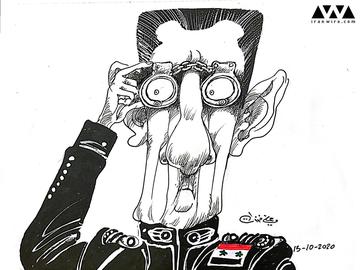According to one Armenian expert, Russia remains indecisive about what to do in the current war between Armenia and Azerbaijan over Nagorno-Karabakh. But one thing is certain: Russia is using media to influence both sides in an effort to achieve its goals, and to keep its options open.
On September 27, a war broke out in the Nagorno-Karabakh enclave between the local ethnic Armenian government and Azerbaijan. The enclave is officially part of Azerbaijan but is run by ethnic Armenians who do not want to be part of Azerbaijan and are supported by Armenia. The war has claimed hundreds of lives so far — if not thousands — and has become a battleground for disinformation between several regional players including Russia, Iran, and Turkey.
Samvel Martirosyan, an expert and co-founder of CyberHUB-AM, which provides digital security for civil society and media in Armenia, says Russia has an active media campaign but that it is still unsure how to respond to the current crisis between the two countries. Both had been a part of the Soviet Union, so both have close ties to Russia. On one side, Russia has interests in Armenia, with which it has a defense pact, but on the other side, in recent years it has profited from selling weapons to Azerbaijan.
“Russia is involved very intensively, and we see that Russian trolls are trying to spread specific information – but supporting both sides, which is interesting,” says Martirosyan, adding that Russian media aims different messages at different audiences.
“At the moment, Russia seems divided in its media coverage and tries to influence both sides, but most Russian journalists are working on the Armenian side because Azerbaijan has only let a few foreign journalists report in Azerbaijan,” he says.
Armenia and Azerbaijan have clashed over Nagorno-Karabakh for many years, and the two countries fought a bloody war in the early 1990s soon after the breakup of the Soviet Union.
“At the moment, Russia is mostly trying to use manipulative political techniques,” says Martirosyan, pointing to the example of Russia blaming Turkey for the current war when addressing its Armenian audience on television, websites, and social media.
Russia Offers the Only Solution
There have been increasing reports about Azerbaijan using Syrian mercenaries in the current war in Nagorno-Karabakh, and Russia has used this to incite fear and a feeling of instability in Armenia. Martirosyan says that Russian media reports are based on truth, but facts are chosen selectively.
“Russia then offers the solution: That Armenia, where it does not like the current government, is too small to survive independently. That it needs Russia. That it is the only chance for its survival,” says Martirosyan, “That Armenia needs to become part of the Russian Federation.”
An example of that is seen on the Russian state TV channel RT. The channel has focused much of its reporting on Russia’s role in mediating the conflict and how Armenia needs Russia, quoting the Azerbaijani president saying: “Russia came to save Armenia.”
On social media, Russia is also pushing the idea that Armenia’s prime minister, Nikol Pashinyan, who was elected after the Armenian revolution in 2018, is a puppet of George Soros – the scapegoat of many conspiracy theories. The conclusion is that everything would be better with a more decisive pro-Russian leader in Armenia, Martirosyan says.
In Azerbaijan, Russia is playing a completely different game, praising the Azerbaijani President Ilham Aliyev for being a strong leader, but saying that it is wrong to use Syrian fighters and rely on the support of Russia’s regional opponent Turkey.
“They are, for example, referring to how Aliyev graduated from a Russian diplomatic University (Moscow State Institute of International Relations) and that it makes him a good guy,” he says.
Russia has also spread lies on smaller Russian news outlets such as Avia.pro. One story, for example, stated that Iran has been bombing Azerbaijani territory. This has not been confirmed.
Russia Trying to Gain From War
Martirosyan says that Russia’s media strategy uses what works in Armenia and in Azerbaijan respectively because Russia is trying to exploit the current conflict in the region to bring both countries closer to it. He says many people have pointed out that only Russia has the means to end the current crisis, but it has not done so because it might still have something to achieve.
“Russia is not trying to be neutral in their coverage,” he says, “At the moment, they are more pro-Armenia, which is a change from what we have seen in the last few years and might be due to the Turkish influence in Azerbaijan.”
On October 10, Russia managed to bring Armenia and Azerbaijan to the negotiating table in Moscow and agree to a truce, which, among other things, allowed the exchange of prisoners. There was hope that it would bring peace, but shelling resumed only five minutes after its implementation.
“It might look like a failure for Russia, but in Armenia, Russian media have pointed out that it was not a peace deal as such, but that instead it was just an exchange of prisoners. Russia is still keeping its cards open,” says Martirosyan, adding that he is sure if events on the ground go against Russia's interests, Russia could become even more prolific in its disinformation about the conflict.
For now, it is still Armenia and Azerbaijan who are most actively using disinformation, Martirosyan says. Both sides have introduced restrictions on the media, and have launched social media campaigns and reports about each side hacking websites and phones of the other side. Furthermore, there are claims that both sides use trolls to spread information on social media.
visit the accountability section
In this section of Iran Wire, you can contact the officials and launch your campaign for various problems



























comments